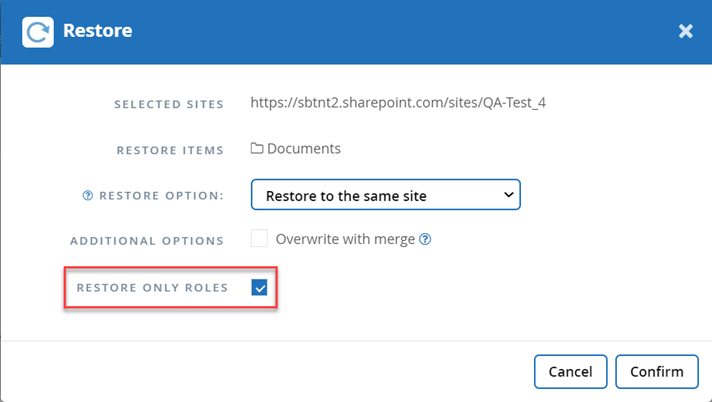Perform a granular-level restore for Microsoft SharePoint Online
 Suggest changes
Suggest changes


Within Microsoft SharePoint Online, you can restore granular-level items for a single user, such as individual folders or files. You can also restore granular-level items for a Microsoft 365 group site and OneNote notebooks. Site roles and permissions are protected automatically as part of a restore or backup.
By default, only the most recent backup is available for restore. Other available options include:

The table indicates the restore options that are supported for granular-level items.

|
For the restore options Restore to the same site and Restore to another site, the following items restore as subsites under the selected site with the naming convention <sitename_cc_timestamp>: Single site, multiple sites, and single/multiple lists if 3 or more lists are selected. |
| Type of item | Restore to the same site | Restore to another site | Export data | Where to find it in SaaS Backup |
|---|---|---|---|---|
Single/multiple items |
Yes |
Yes |
No |
SharePoint Online > Sites > <Site Name> > <List Name> |
Single site |
Yes |
Yes |
Yes |
SharePoint Online > Sites |
Multiple sites |
Yes |
Yes |
No |
SharePoint Online > Sites |
Communication sites |
No |
No |
No |
SharePoint Online > Sites |
Single/multiple subsites |
Yes |
Yes |
Yes |
SharePoint Online > Sites > <Site name> > Subsites |
Single/multiple folders |
Yes |
Yes |
Yes |
SharePoint Online > Sites > <Site name> > <List name> |
Single/multiple lists |
Yes |
Yes |
Yes |
SharePoint Online > Sites > <Site name> |
OneNote single/multiple notebooks |
Yes |
Yes |
Yes |
SharePoint Online > Sites > <Site name> > <List name> |
OneNote single/multiple section groups |
Yes |
Yes |
Yes |
SharePoint Online > Sites > <Site name> > <List name> > <Notebook folder> |
OneNote single/multiple sections |
Yes |
Yes |
No |
SharePoint Online > Sites > <Site name> > <List name> > <Notebook folder> |
-
From the Dashboard, click the number above PROTECTED in the SharePoint box.
-
Click the site for which you need to perform the granular-level restore.
-
Select the category that you need to restore.
If you want to restore specific individual items inside a category, click the content category and then select the individual items. -
To restore from the most recent backup, click Restore. To restore a previous version of the item, click Show versions, and select the version that you want to restore and then click Restore.
-
Select a restore option:
-
Restore to the same site
If you restore to the same site, by default, a restore folder with the current date and time stamp is created in the original file location containing the backup copy.If you select Restore only roles, Overwrite with merge, or Replace the existing content, the only restore option is Restore to the same site.
If you select Restore to the same site Restore only roles
all types of items
Overwrite with merge
all items except site level
Replace with existing content
item level only
If you select Restore Only Roles, only the roles and permissions restore.

If you select the Overwrite with merge option, no restore folder is created. If the version of the backup file and the current file match, the backup is restored to the original location. Any new content in the destination is ignored and unaffected. For example, if the backup contains File1 version5 and the destination contains File1 version 6, a restore with the Overwrite with Merge option selected fails.
If you select the Replace the existing content option, the current version of the data is completely replaced with the backup copy.
-
Restore to another site
If you restore to another site, you must enter the destination site in the search field. You can type a portion of the site in the search field to initiate an automatic search for matching sites.
-
Export Data
If you export data, you need to download it. Go to Reporting on the left menu. Find your export data job. Click on Total Folders. Then click Export Data Download Link. A zip file downloads. Open the zip file to extract the data.
If you select the Export Data restore option, the provided link is valid for seven days and is pre-authenticated.
-
-
Click Confirm.
A message is displayed indicating that the restore job was created.
-
Click View the job progress to monitor the progress of the restore.


